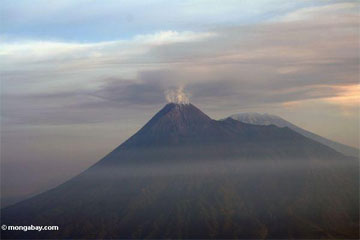Geoengineering cure for global warming could cause problems
Proposed cure for global warming could cause problems
mongabay.com
August 14, 2007
Proposed geoengineering schemes to reduce global warming may do more harm than good, warns a new study published in Geophysical Research Letters.
Based on observations of the global temperature effects from aerosols released during volcanic eruptions, some scientists have proposed scattering light-reflecting sulfate particles in the atmosphere as a way to mitigate climate change. Paul J. Crutzen, winner of the 1995 Nobel Prize in Chemistry for his work on the hole in the ozone layer, has said that injecting sulfur into the atmosphere could slow global warming by reflecting solar radiation back into space.
Now a new paper by Kevin E. Trenberth and Aiguo Dai of the National Center for Atmospheric Research, in Boulder Colorado, cautions that volcanic eruptions have other climate effects. Examining precipitation and streamflow records from 1950 to 2004 to measure the effects of volcanic eruptions from Mexico’s El Chichón (1982) and the Philippines’ Pinatubo (1991), the authors show that the eruption of Pinatubo caused “substantial global decrease in precipitation over land, a record decrease in runoff and river discharge into the oceans, and widespread drying over land during the following year”
 Volcano outside Yogjakarta on the island of Java, Indonesia |
Trenberth and Dai conclude that “major adverse effects, including drought, could arise from geoengineering solutions to global warming,” according to Geophysical Research Letters.
CITATION: Kevin E. Trenberth and Aiguo Dai (2007). Climate change and geoengineering: Is the cure worse than the sickness?. Geophysical Research Letters August 14, 2007
Related articles
Geoengineering could stop global warming but carries big risks. Using radical techniques to “engineer” Earth’s climate by blocking sunlight could cool Earth but presents great risks that could well worsen global warming should they fail or be discontinued, reports a new study published in the June 4 early online edition of The Proceedings of the National Academy of Sciences.
WWF condemns iron fertilization scheme to fight global warming. Environmental group WWF condemned a scheme by Planktos, Inc. (OTCBB: PLKT) to dump up to 100 tons of iron dust in the open ocean west of the Galapagos Islands. The firm claims the experiment will fertilize massive blooms of phytoplankton that will absorb carbon dioxide from the atmosphere and help fight global warming. The plan, which relies on the use of foreign vessels to skirt the U.S. Ocean Dumping Act, has been widely criticized by environmentalists, who say it could be damaging to the rich array of species living in the waters near the Galapagos, including 400 species of fish, turtles, penguins, marine iguanas, and corals.
Nuclear war could cause global cooling (i.e. block global warming). Nuclear war would disrupt global climate for at least a decade according to new research presented Dec. 11 at the annual meeting of American Geophysical Union in San Francisco. The research, based on findings from historic volcano eruptions, found that a small-scale, regional nuclear war could produce millions of tons of “soot” particles that could block solar radiation, in effect, cooling the planet.
Pollution could be used to fight global warming. A Nobel Prize-winning scientist caused a stir Wednesday at the U.N. climate conference in Nairobi when he said “pollution” could be used to help fight global warming. Paul J. Crutzen, winner of the 1995 Nobel Prize in Chemistry for his work on the hole in the ozone layer, said that injecting sulfur into the atmosphere could slow global warming by reflecting solar radiation back into space. The plan would use balloons carrying artillery guns to fire sulfates into the stratosphere. Unlike greenhouse gas emissions, which feature a lag-time in heating the globe, the climatic response from sulfate injection would take effect within six months and the reflective particles would remain in the stratosphere for up to two years.